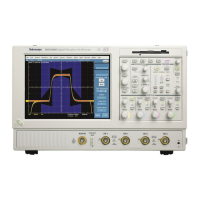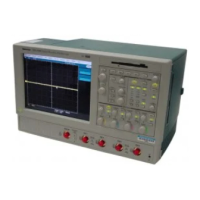TDS5000B Online Programmer Guide
-- 5 5 7 --
H PHAse
This measures the phase difference (amount of time a waveform leads
or lags the reference waveform) between two waveforms. The mea-
surement is made between the middle reference points of the two wa-
veforms and is expressed in degrees, where 360° represents one wave-
form cycle.
H PK2Pk
This peak--to--peak amplitude measurement finds the absolute differ-
ence between the maximum and minimum amplitude in the entire
waveform or gated region.
When histogram is selected with the MEASUrement:METHod com-
mand, the PK2Pk measurement measures the histogram’s peak to
peak difference.
H PKPKJitter
This measures the variance (minimum and maximum values) in the
time locations of the cross point.
H PKPKNoise
This measures the peak--to--peak noise on a waveform at the mid ref-
erence level.
H POVershoot
The positive overshoot amplitude measurement finds the positive
overshoot value over the entire waveform or gated region.
Positive Overshoot = (Maximum – High) / Amplitude * 100%
H PTOT
This measures the top value used in extinction ratio measurements.
H PWIdth
The positive width is the distance (time) between the middle reference
(default = 50%) amplitude points of a positive pulse. The measure-
ment is made on the first pulse in the waveform or gated region.
H QFACtor
This measures the quality factor. The Q factor is a figure of merit for
an eye diagram, which indicates the vertical eye opening relative to
the noise at the low and high logic levels. It is the ratio of the eye size
to noise.
H RISe
This timing measurement finds the rise time of the waveform. The
rise time is the time it takes for the leading edge of the first pulse en-
countered to rise from a low reference value (default is 10%) to a high
reference value (default is 90%).
H RMS
This amplitude measurement finds the true Root Mean Square voltage
in the entire waveform or gated region.

